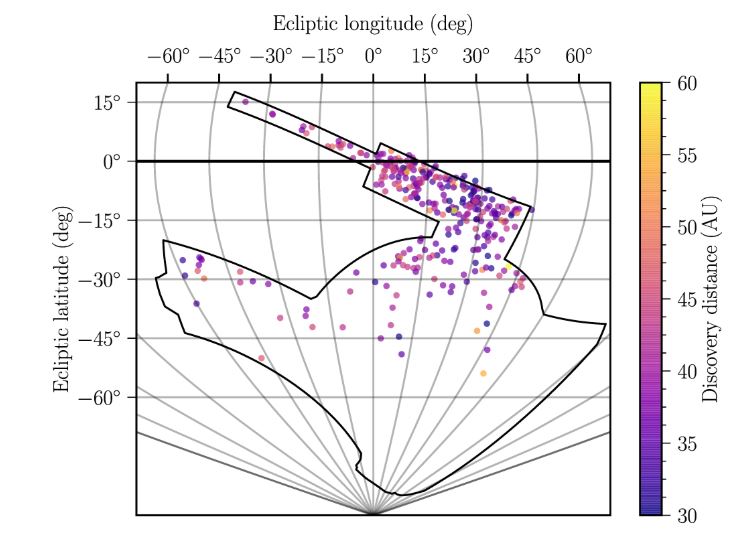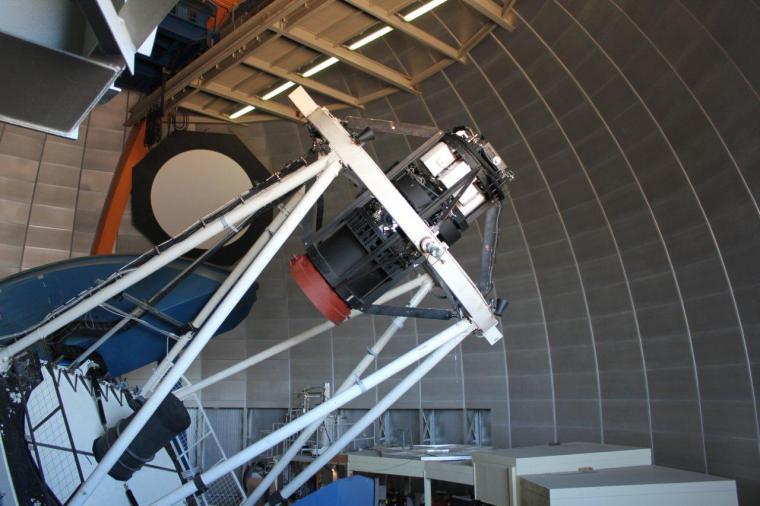https://blog.wongcw.com/2020/03/13/%E4%B8%80%E7%A8%AE%E6%96%B0%E6%8A%80%E8%A1%93%E5%8F%AF%E4%BB%A5%E5%B9%AB%E5%8A%A9%E5%A4%A9%E6%96%87%E5%AD%B8%E5%AE%B6%E6%89%BE%E5%88%B0%E6%96%B0%E7%9A%84%E5%B0%8F%E8%A1%8C%E6%98%9F/利用暗能量巡天(DES)的數據發現了300多個 TNO 海王星外天體
DES現在已經完成了六年的數據收集,其目標是在收集南方天空的高精度圖像,同時了解暗能量的性質。DES並不是專門為尋找TNO而設計的,但是其觀測結果所提供的覆蓋範圍,使其能夠熟練地發現海王星以外的物體。DES旨在研究星系和超新星,這種設計意味著研究人員必須開發一種跟踪運動的新方法。專門針對TNO的調查,通常每隔一兩個小時進行一次測量。
這使得科學家們能夠看到運動,從而很容易追踪到物體。利用DES最初四年的數據,研究小組從一個70億點的數據集開始。每一個點都是一個可能的目標,它們由軟件檢測,高於圖像的背景水平。這些物體包括恆星,星系和超新星。剩下的只是瞬態物體,其中有2200萬。
然後,該團隊尋找附近三對檢測到的物體,以確定其在隨後的夜晚出現的位置。最終,在至少六個晚上觀看到有400個候選物體,然後科學家堆疊圖像以創建更清晰的視圖,以幫助確認它們是否為真實的TNO。在研究結束時,研究小組發現了316個TNO,
包括 139個以前未發現的新物體。
 https://www.universetoday.com/145367/over-a-hundred-new-large-objects-found-in-the-kuiper-belt/
https://www.universetoday.com/145367/over-a-hundred-new-large-objects-found-in-the-kuiper-belt/DES= Dark Energy Survey (DES)
After many months of work, the researchers whittled their findings down to 316 TNOs, which included 139 new objects that were not previously known. The team said that with only 3,000 objects currently known, this DES catalog represents 10% of all known TNOs.
The location of the newly found TNOs range from 30 to 90 AU (astronomical units), or 30 to 90 times Earth’s distance from the Sun. Pluto is about 40 AU.
Bernardinelli said he will be using his methods to search for more TNOs in the subsequent two years’ dataset from DES’ six year observing run. (Each year’s observing ‘season’ runs from August to February.) And he also hopes to use it with data from the new Vera C. Rubin Observatory, which will survey the entire southern sky, and has the ability to detect even fainter and more distant objects than DES. And who knows…. Maybe the speculated Planet Nine could be found using these new methods.

DECam, near center of image, is deployed at the focus of the 4-meter Victor M. Blanco optical telescope in Chile. Credit: Dark Energy Survey Collaboration.
 會員專區
會員專區 
